
A great way to soften the blow of bad news is to quickly follow it up with something positive. Mazda knows this trick well it seems, because fresh on the heels of announcing it was discontinuing its venerable and much-loved Mazda 6 mid-size sedan/wagon, it revealed it would be replacing it with the car you see here – the Mazda 6e.
This was good news for a few reasons. Firstly, the 6e looks great with the kind of striking exterior and luxurious interior to properly turn heads and, Mazda will be hoping, to open buyer’s wallets. More importantly, though, is the fact that the 6e is powered solely by electricity.
That makes it Mazda’s first proper tilt at an electric car (its previous attempt, the MX-30 was a low-selling curio) and on paper the 6e stacks up almost identically against the Tesla Model 3 for size, performance and price.
So far, so good, but despite its on-paper promise a key question mark remains: what’s the 6e like to drive? Unlike every other Mazda in Aussie showrooms, the 6e isn’t made in Japan. It’s made in China in a joint venture with Mazda’s Chinese business partner, Changan, and underneath the 6e uses the same platform and powertrain hardware as the Deepal SL03.
Which begs the question: does the 6e feel like a proper Mazda, with the kind of well-sorted driving dynamics and sporty steering the brand is famous for? Or is it a rebadged Deepal? We had a brief drive of a left-hand drive pre-production model ahead of its mid-2026 Australian launch to find out.
Mazda has earmarked the middle of 2026 to launch the 6e in Australia, which means we’ll have to wait until next year for official pricing. Encouragingly, though, Mazda says it’s targeting a price of “under $55,000 before on-roads” for the 6e’s entry-level variant. That will see it line-up almost identically to the Tesla Model 3 Rear-Wheel Drive which currently starts at $54,900 before on-roads. Other rivals will include the Polestar 2 (from $62,400), BYD Seal (from $49,888) and Hyundai Ioniq 6 (from $67,300).
Mazda is yet to confirm what the 6e model range will look like in Australia but there will be multiple trim levels, ranging from the base $55K variant up to a more luxurious flagship which will feature a more richly trimmed cabin and more standard equipment. The car we’re driving is based on a German specification and reflects what will likely be the most expensive variant in Australia.
Regardless of its trim level, every 6e will share the same core mechanical package: a 78kWh lithium iron phosphate (LFP) battery that powers a single electric motor on the rear axle making 190kW. Driving range will be “over 500km WLTP”.
Size-wise, the 6e is 4921mm long, 1890mm wide and 1485mm tall. It rolls on a 2900mm wheelbase. Compared to the now defunct Mazda 6 sedan, it is 121mm longer, 50mm wider and 5mm taller. The 6e’s wheelbase is 70mm longer, which translates into more space inside the cabin.
Unlike the outgoing Mazda 6, the 6e won’t be offered as a wagon meaning it’s sedan only. Changan does make a similarly sized SUV however, sold as the Deepal EZ-60, and it’s strongly tipped to make its way to Australia where it will be badged as the CX-6e.
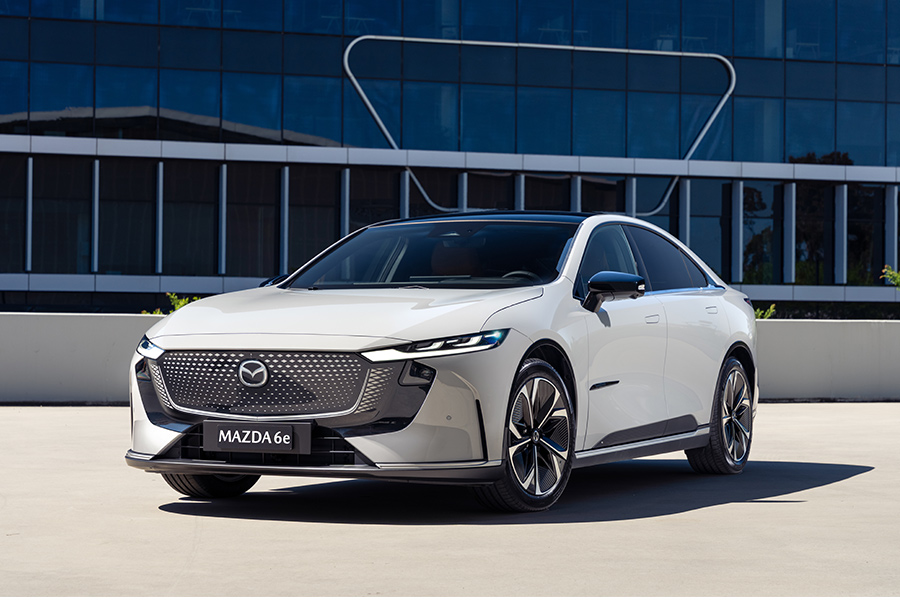
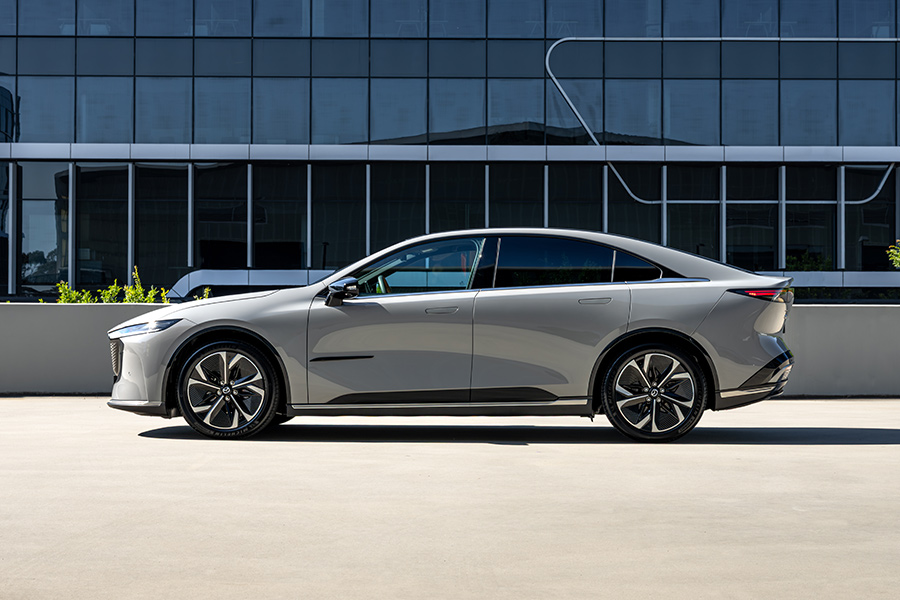


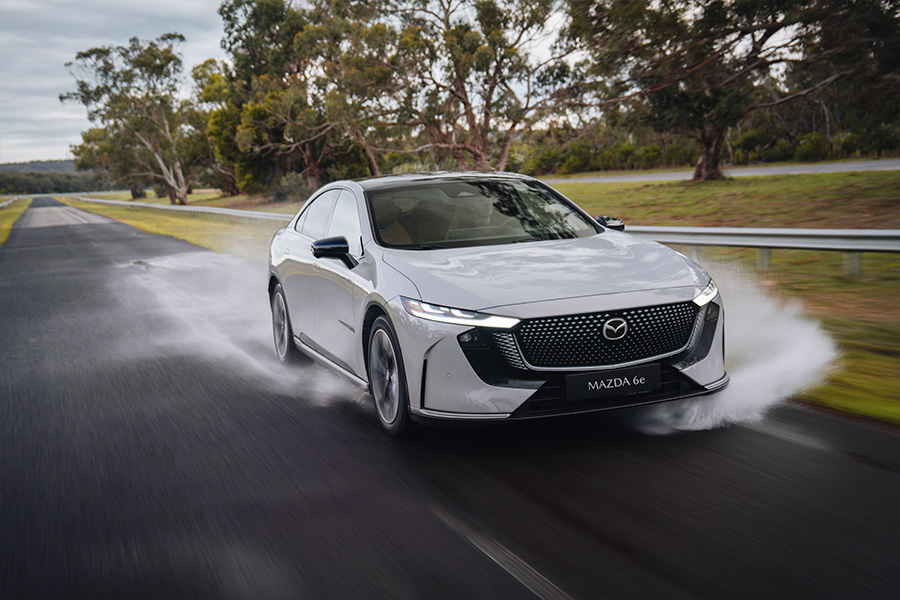
Much like its handsome exterior, the Mazda 6e’s cabin makes a strong first impression. Our test car is a high-spec variant and it greets you with swathes of tan suede and soft leather as you open the door (which is frameless for a welcome touch of glamour). The detailing is impressive, too, with diamond stitching on the seats and Mazda badging on the steering wheel and headrests.
There’s also no faulting the sense of space or storage. Both rows can easily accommodate 6ft adults and the comfortable rear seats include dedicated air vents, a flat floor, centre armrest with cup holders, ISOFIX anchor points on the outboard seats, and three top-tether mounts for child seats. The boot is also impressively deep (expect around 400L of luggage space; exact litreage is unconfirmed) and pairs with a 72L frunk which looks large enough to swallow a carry-on suitcase.
Front cabin storage is generous thanks to a deep cubby at your elbow and a cavernous shelf beneath the centre console. Cabin materials also feel high quality, with the only exception being some hard plastic near the door pulls.
Another weakness is the driving position. Taller drivers will likely find the seat base feels a couple of inches too high and the steering wheel’s reach adjustment doesn’t extend far enough, meaning an uncomfortable compromise has to be reached.
The biggest departure, however, and the clearest indication that the 6e is a rebadged Deepal is the centre screen and layout of the key controls. Mazda is famously fastidious when it comes to the ‘human machine interface’ of its models and is one of the few brands to resist cramming everything inside a large centre screen.
The 6e is different. An enormous 14.6-inch touchscreen adorns the dash and, just like a Tesla, it controls almost everything. Need to open the boot? Want to adjust the sensitivity for the adaptive cruise or even the wipers? Prepare to dive into the centre screen menu. Another departure is the fonts used on the screen and digital instrument display, which are more generic than Mazda’s usual elegant and easy to read typeface.

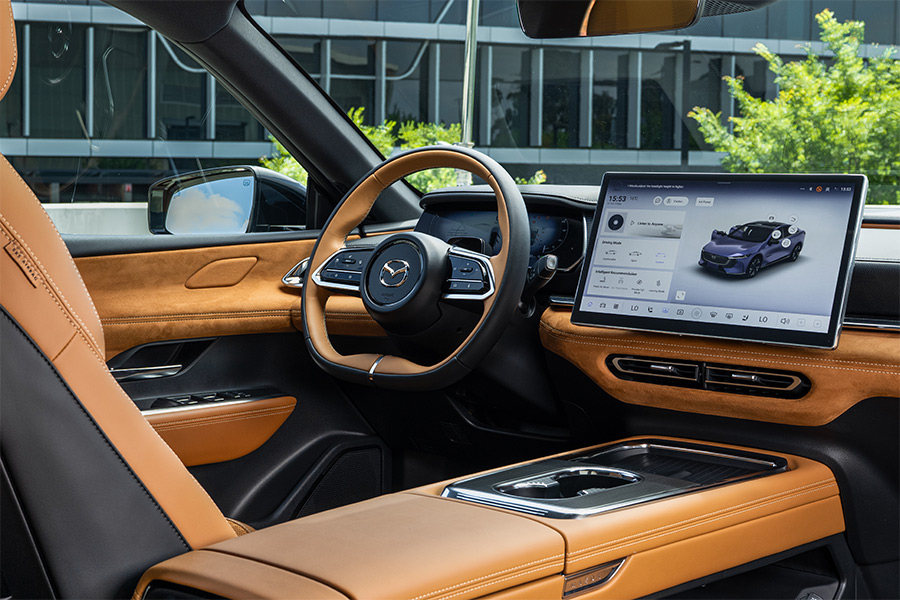
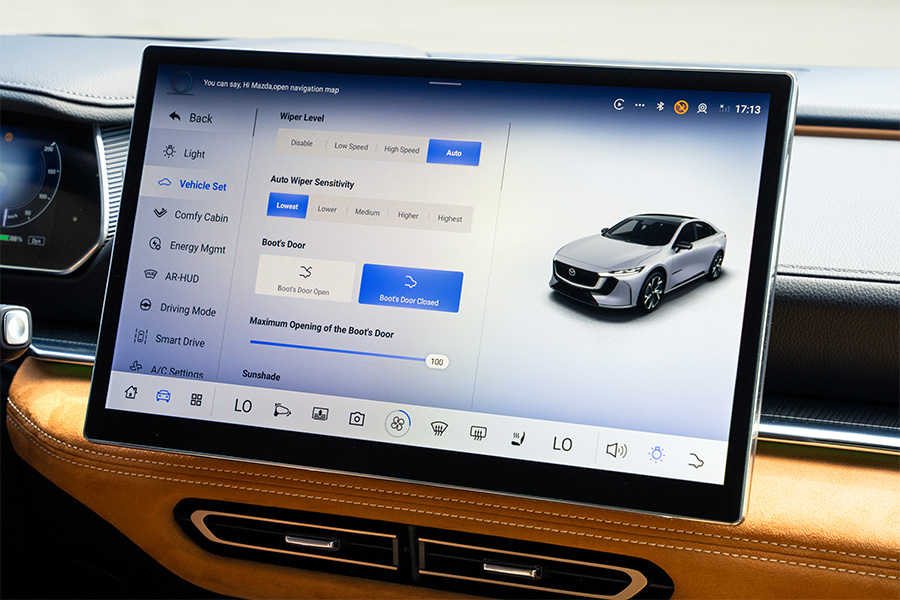
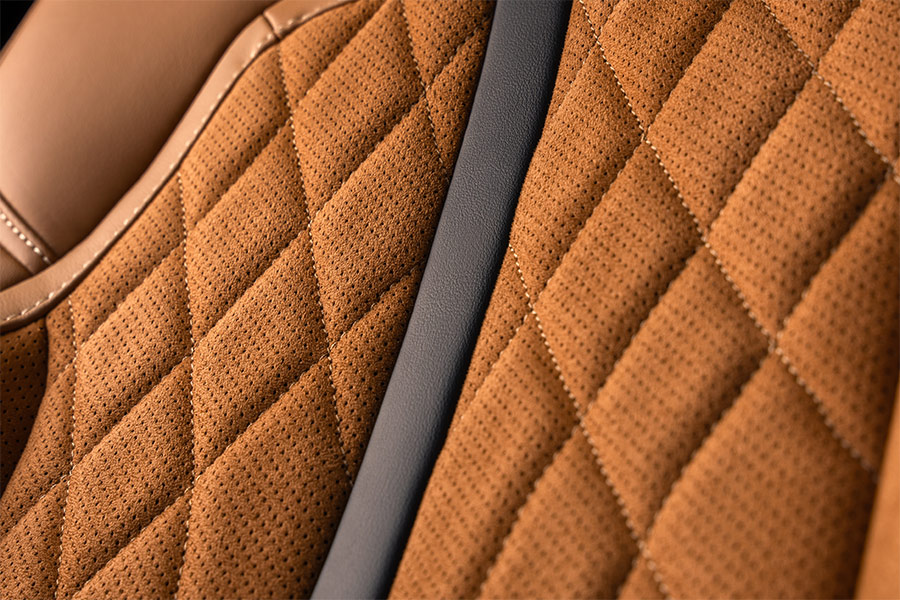
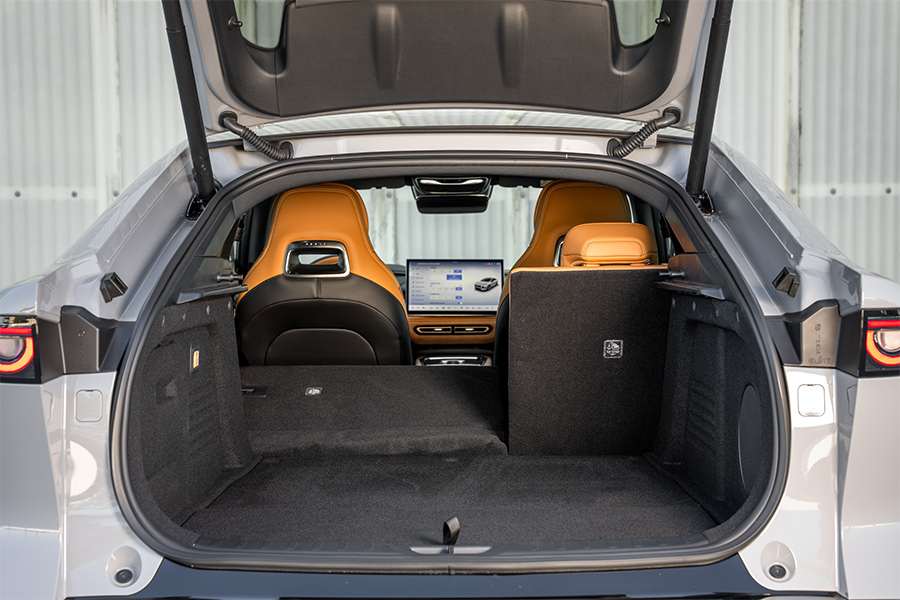
Mazda is yet to lock in its exact Australian line-up so we’ll have to wait until early next year before we get a model-by-model breakdown of how the 6e is equipped. It is clear, however, that the flagship model should be bursting with standard features. Our high-spec test car included Nappa leather and suede upholstery, electric seats with heating and cooling, tri-zone climate control, LED lights front and rear, a Sony sound system, and a large panoramic sunroof with electrically operated blinds. Like most electric cars, the Mazda 6e doesn’t include a spare tyre.
— Alex Inwood
The Mazda 6e was awarded a five star safety rating by Euro NCAP in October 2025. We’ll have to wait until next year to discover which safety systems are included as standard on Australian-spec cars but in Europe the 6e is fitted with the following: autonomous emergency braking with cyclist and pedestrian detection, lane assist, fatigue/distraction detection and cyclist dooring prevention. Adaptive cruise control is also available.
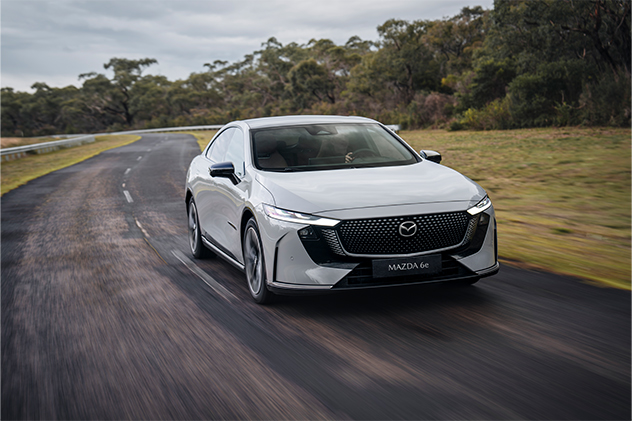
In further good news, Mazda has recalibrated the 6e’s active safety systems to reduce distracting beeps and bongs.
“We are driven by some NCAP regulations to get our stars and there are many things which are good for NCAP but not for the customer,” said Mazda Europe’s senior manager for product development, Alexander Fritsche. “The sounds [safety beeps] were reduced and the rate of introduction of some systems are much milder."
Australian versions of the 6e will be powered by a 78kWh lithium iron phosphate (LFP) battery, which Mazda says will provide “over 500km” of driving range. The battery powers a single electric motor mounted on the rear axle and power is rated at 190kW. Mazda Australia is yet to confirm a torque figure, although European cars are rated at 320Nm. If those outputs sound familiar, they’re in the same ballpark as the Tesla Model 3 Rear-Wheel Drive.
Recharging rates are also yet to be confirmed for our market, with Mazda simply saying the 6e has “fast recharging” and can achieve a 30-80 per cent charge in around 15 minutes. In Europe the 6e has a peak DC recharging rate of either 90kW or 165kW depending on which battery is fitted. Both battery packs available in Europe are different to the one for our market, however, so a direct comparison is difficult.
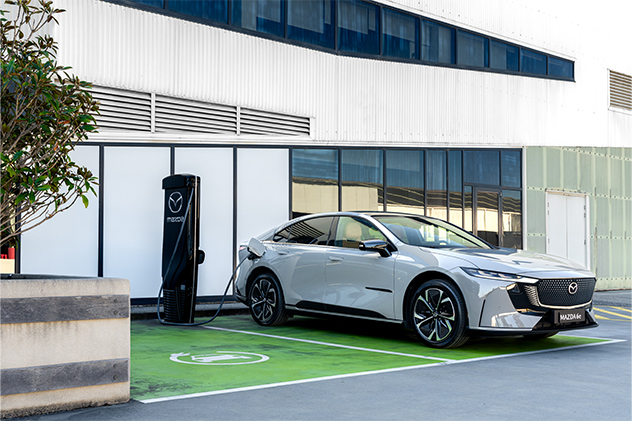
How the 6e drives is important primarily because Mazda has a hard-earned reputation to uphold. Mazdas are consistently some of the best handling cars in their segments and while it’d be a stretch to say every model feels like a MX-5, there is a sporty flavour to their dynamics that is consistent across the range.
The 6e, however, feels notably different. The change in character begins as soon as you sit behind the wheel and notice there’s no starter button to navigate. Instead the 6e is like a Tesla or Polestar; you simply get in, put your foot on the brake and engage drive.
Mazda’s European division spearheaded the 6e’s development and it’s evident they have worked hard to improve the dynamics. Changes included designing an entirely new rear suspension subframe, fitting thicker anti-roll bars, and increasing spring and damper rates in an effort to increase chassis stiffness and improve body control. The steering hardware and software was also altered to impart more of a ‘Mazda feel’.
“The Chinese seem to be going for a very, very light and low feedback feeling, so we increased the build up and the linearity,” said Alexander Fritsche, who oversaw Mazda Europe's chassis alterations. Another key change was swapping out the Chinese-spec tyre for a Michelin e-Primacy which “is providing more rigidity, more harshness control and also good rolling resistance” according to Fritsche. The wheel and tyre package runs 245/45 R19 and will be the same across all models in Australia.
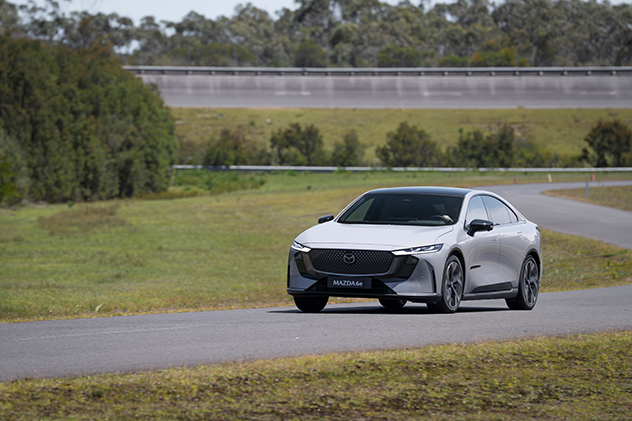
The 6e rides on passive suspension (no adaptive dampers are available) and the good news is Mazda’s European tuning has struck a final balance between comfort and control. While unquestionably more softly sprung than most Mazdas, the 6e rarely feels wallowy. Lumps and bumps are easily absorbed and body control is mostly impressive on twisty roads, with the car’s near two-tonne mass only apparent over big compressions or sudden changes of direction.
The steering is less convincing. According to Fritsche the steering ratio in the Deepal donor car “is very aggressive in comparison to the classical Mazda vehicles; it’s much shorter” and despite Mazda’s tweaks it still feels overly quick and direct for the size of the car, at least initially. It lacks feedback and connection, too. In Comfort mode the steering is overly light and vague and the way its weight builds as you add more lock in a corner isn’t linear. Sport mode adds weight and heft but the same fundamental issues remain.
The brakes also lack Mazda’s usual finesse, with the pedal in our pre-production car feeling inconsistent and spongy. And while three levels of regenerative braking are available it’s difficult to discern much of a difference between the modes. Even in its strongest setting, the 6e’s regen isn’t close to one-pedal driving.
Performance wise the 6e feels well judged for a mid-size sedan. Acceleration is brisk rather than fast (moving a kerb weight of almost two-tonnes is no small feat) but the drivetrain’s instant torque and response mean drivers should slot easily into gaps in traffic and execute overtakes with confidence. As for consumption, the long-term average on our test car was 23.4kWh over 780km of driving. With a 78kWh battery that translates to a real-world driving range of around 340km.
So does the 6e feel like a proper Mazda to drive? The simple answer, at least from this brief prototype drive, is no. But that shouldn’t dull the sheen of what is otherwise an attractive and convincing electric sedan. Final pricing and local specification will have a big bearing on how successful it is sales wise but if Mazda can hit its targets, and complement the 6e sedan with the CX-6e SUV, it will finally have worthwhile contenders in Australia’s growing EV market.